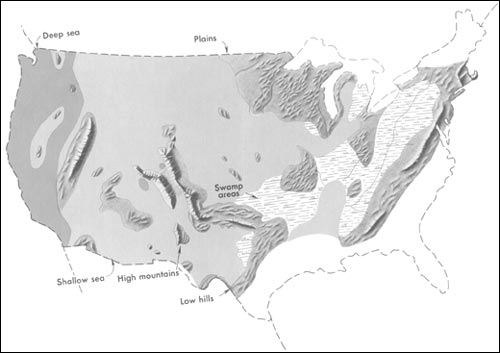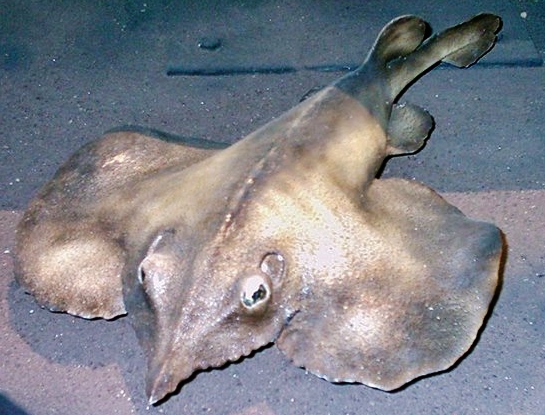|
Petalodont
Petalodontiformes ("thin-plate teeth") is an extinct order of marine cartilaginous fish related to modern day chimaera found in what is now the United States of America and Europe.Lund, Richard, E. D. Grogan, and M. Fath. "On the relationships of the Petalodontiformes (Chondrichthyes)." Paleontological Journal 48.9 (2014): 1015-1029. Most species are known only from isolated teeth.Dalla Vecchia, Fabio Marco, and Museo Paleontologico Cittadino. "A new petalodont tooth (Chondrichthyes, Petalodontiformes) from the Lower Permian of the Carnic Alps (Friuli, NE Italy)." Bollettino della Società Paleontologica Italiana 39 (2000): 225-228. All fossils range from the Carboniferous to the Permian, where they are presumed to have died out during the Permian/Triassic extinction event. The two best known species are '' Belantsea montana'', from the Carboniferous Bear Gulch, Montana, and '' Janassa bituminosa'', from the upper Permian The Permian ( ) is a geologic period and stratig ... [...More Info...] [...Related Items...] OR: [Wikipedia] [Google] [Baidu] |
Bear Gulch Limestone
The Bear Gulch Limestone is a limestone-rich geological lens in central Montana, renowned for the quality of its late Mississippian-aged fossils. It is exposed over a number of outcrops northeast of the Big Snowy Mountains, and is often considered a component of the more widespread Heath Formation. The Bear Gulch Limestone reconstructs a diverse, though isolated, marine ecosystem which developed near the end of the Serpukhovian age. It is a lagerstätte, a particular type of rock unit with exceptional fossil preservation of both articulated skeletons and soft tissues. Bear Gulch fossils include a variety of fish, invertebrates, and algae occupying a number of different habitats within a preserved shallow bay. Fish include a high diversity of unusual chondrichthyans (cartilaginous fish) and one of the oldest known lampreys, along with other vertebrates. Invertebrates include numerous fossils of crustaceans, worms, cephalopods, and sea sponges, which are concentrated in different ... [...More Info...] [...Related Items...] OR: [Wikipedia] [Google] [Baidu] |
Belantsea Montana
''Belantsea'' (named after a legendary ancestor of the Crow Nation) is a genus of extinct petalodontid cartilaginous fish that lived during the Lower Carboniferous, about 350 million years ago. Its fossils are found in the Bear Gulch Limestone lagerstätte. Its body was leaf-shaped, with muscular fins and a small tail. Such a body plan would allow for great maneuverability, but at the cost of speedy cruising. Its few, large, triangular teeth formed a beak-like arrangement that allowed it to graze bryozoans, sponges, crinoids, and other encrusting animals. The genus contains two species, ''B. montana'' and ''B. occidentalis''. ''Belantsea'' is the best known member of the order Petalodontiformes Petalodontiformes ("thin-plate teeth") is an extinct order of marine cartilaginous fish related to modern day chimaera found in what is now the United States of America and Europe.Lund, Richard, E. D. Grogan, and M. Fath. "On the relationships o .... References External links Bear ... [...More Info...] [...Related Items...] OR: [Wikipedia] [Google] [Baidu] |
Petalodontidae
Petalodontidae is an extinct family of marine cartilaginous fish related to modern day chimaera found in what is now the United States of America and Europe. With a very few exceptions, they are known entirely from teeth. All fossils range from the Carboniferous to the Permian The Permian ( ) is a geologic period and stratigraphic system which spans 47 million years from the end of the Carboniferous Period million years ago (Mya), to the beginning of the Triassic Period 251.9 Mya. It is the last period of the Paleoz ..., where they are presumed to have died out during the Permian/Triassic extinction event. References External links Petalodontidae at merriam-webster.comPetalodontidae at biolib.cz Petalodontiformes Carboniferous cartilaginous fish Permian cartilaginous fish Permian extinctions Prehistoric cartilaginous fish families Mississippian first appearances {{Paleo-cartilaginous-fish-stub ... [...More Info...] [...Related Items...] OR: [Wikipedia] [Google] [Baidu] |
Carboniferous
The Carboniferous ( ) is a geologic period and system of the Paleozoic that spans 60 million years from the end of the Devonian Period million years ago (Mya), to the beginning of the Permian Period, million years ago. The name ''Carboniferous'' means "coal-bearing", from the Latin '' carbō'' (" coal") and '' ferō'' ("bear, carry"), and refers to the many coal beds formed globally during that time. The first of the modern 'system' names, it was coined by geologists William Conybeare and William Phillips in 1822, based on a study of the British rock succession. The Carboniferous is often treated in North America as two geological periods, the earlier Mississippian and the later Pennsylvanian. Terrestrial animal life was well established by the Carboniferous Period. Tetrapods (four limbed vertebrates), which had originated from lobe-finned fish during the preceding Devonian, became pentadactylous in and diversified during the Carboniferous, including early amphibian lin ... [...More Info...] [...Related Items...] OR: [Wikipedia] [Google] [Baidu] |
Carboniferous Cartilaginous Fish
The Carboniferous ( ) is a geologic period and system of the Paleozoic that spans 60 million years from the end of the Devonian Period million years ago (Mya), to the beginning of the Permian Period, million years ago. The name ''Carboniferous'' means "coal-bearing", from the Latin '' carbō'' ("coal") and '' ferō'' ("bear, carry"), and refers to the many coal beds formed globally during that time. The first of the modern 'system' names, it was coined by geologists William Conybeare and William Phillips in 1822, based on a study of the British rock succession. The Carboniferous is often treated in North America as two geological periods, the earlier Mississippian and the later Pennsylvanian. Terrestrial animal life was well established by the Carboniferous Period. Tetrapods (four limbed vertebrates), which had originated from lobe-finned fish during the preceding Devonian, became pentadactylous in and diversified during the Carboniferous, including early amphibian linea ... [...More Info...] [...Related Items...] OR: [Wikipedia] [Google] [Baidu] |
Petalodontiformes
Petalodontiformes ("thin-plate teeth") is an extinct order of marine cartilaginous fish related to modern day chimaera found in what is now the United States of America and Europe.Lund, Richard, E. D. Grogan, and M. Fath. "On the relationships of the Petalodontiformes (Chondrichthyes)." Paleontological Journal 48.9 (2014): 1015-1029. Most species are known only from isolated teeth.Dalla Vecchia, Fabio Marco, and Museo Paleontologico Cittadino. "A new petalodont tooth (Chondrichthyes, Petalodontiformes) from the Lower Permian of the Carnic Alps (Friuli, NE Italy)." Bollettino della Società Paleontologica Italiana 39 (2000): 225-228. All fossils range from the Carboniferous to the Permian, where they are presumed to have died out during the Permian/Triassic extinction event. The two best known species are '' Belantsea montana'', from the Carboniferous Bear Gulch, Montana, and '' Janassa bituminosa'', from the upper Permian The Permian ( ) is a geologic period and stratig ... [...More Info...] [...Related Items...] OR: [Wikipedia] [Google] [Baidu] |
Janassa
''Janassa'' is an extinct genus of petalodont cartilaginous fish that lived in marine environments in what is now central United States of America and Europe during the Carboniferous and upper Permian. It is known from teeth and a few poorly preserved body fossils from Germany ( Kupferschiefer, Upper Permian) and England (Marl Slate, Upper Permian). According to the fossils, ''Janassa'' had a body plan very similar to that of the modern skate. Its teeth suggest it crushed and ate shellfish, such as brachiopod Brachiopods (), phylum Brachiopoda, are a phylum of trochozoan animals that have hard "valves" (shells) on the upper and lower surfaces, unlike the left and right arrangement in bivalve molluscs. Brachiopod valves are hinged at the rear end, ...s. References Petalodontiformes Carboniferous fish of North America Carboniferous cartilaginous fish Permian cartilaginous fish Permian fish of Europe Prehistoric cartilaginous fish genera Fossils of Germa ... [...More Info...] [...Related Items...] OR: [Wikipedia] [Google] [Baidu] |
Cisuralian Taxonomic Orders
The Cisuralian is the first series/epoch of the Permian. The Cisuralian was preceded by the Pennsylvanian and followed by the Guadalupian. The Cisuralian Epoch is named after the western slopes of the Ural Mountains in Russia and Kazakhstan and dates between 298.9 ± 0.15 – 272.3 ± 0.5 Mya. The Cisuralian is often synonymous with the informal terms early Permian or lower Permian. It corresponds approximately with the Wolfcampian in southwestern North America. The series saw the appearance of beetles and flies and was a relatively stable warming period of about 21 million years. Name and background The Cisuralian is the first series or epoch of the Permian. The Cisuralian was preceded by the last Pennsylvanian epoch (Gzhelian) and is followed by the Permian Guadalupian Epoch. The name "Cisuralian" was proposed in 1982, and approved by the International Subcommission on Permian Stratigraphy in 1996. The Cisuralian Epoch is named after the western slopes of the Ural Mountai ... [...More Info...] [...Related Items...] OR: [Wikipedia] [Google] [Baidu] |
Pennsylvanian Taxonomic Orders
Pennsylvanian may refer to: * A person or thing from Pennsylvania Pennsylvania (; (Pennsylvania Dutch: )), officially the Commonwealth of Pennsylvania, is a state spanning the Mid-Atlantic, Northeastern, Appalachian, and Great Lakes regions of the United States. It borders Delaware to its southeast, Ma ... * Pennsylvanian (geology), a geological subperiod of the Carboniferous Period * ''Pennsylvanian'' (train), an Amtrak train {{disambiguation ... [...More Info...] [...Related Items...] OR: [Wikipedia] [Google] [Baidu] |
Mississippian Taxonomic Orders
{{Disambiguation ...
Mississippian may refer to: *Mississippian (geology), a subperiod of the Carboniferous period in the geologic timescale, roughly 360 to 325 million years ago *Mississippian culture, a culture of Native American mound-builders from 900 to 1500 AD *Mississippian Railway, a short line railroad *A native of Mississippi See also *Mississippi (other) Mississippi is a state of the United States of America. Mississippi may also refer to: Places * Mississippi River, a river in central United States * Mississippi River System, a system of rivers in the Mississippi River watershed * Mississippi ... [...More Info...] [...Related Items...] OR: [Wikipedia] [Google] [Baidu] |
Permian Cartilaginous Fish
The Permian ( ) is a geologic period and stratigraphic system which spans 47 million years from the end of the Carboniferous Period million years ago (Mya), to the beginning of the Triassic Period 251.9 Mya. It is the last period of the Paleozoic Era; the following Triassic Period belongs to the Mesozoic Era. The concept of the Permian was introduced in 1841 by geologist Sir Roderick Murchison, who named it after the region of Perm in Russia. The Permian witnessed the diversification of the two groups of amniotes, the synapsids and the sauropsids ( reptiles). The world at the time was dominated by the supercontinent Pangaea, which had formed due to the collision of Euramerica and Gondwana during the Carboniferous. Pangaea was surrounded by the superocean Panthalassa. The Carboniferous rainforest collapse left behind vast regions of desert within the continental interior. Amniotes, which could better cope with these drier conditions, rose to dominance in place of their amphi ... [...More Info...] [...Related Items...] OR: [Wikipedia] [Google] [Baidu] |




